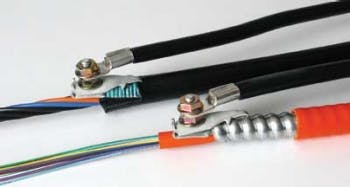
Depending on the type of armor, bonding and grounding may be essential or unnecessary.
Depending on the type of armor, bonding and grounding may be essential or unnecessary.
By Sara Chase, Corning Cable Systems
Armored bulk nanoFIBER fiber-optic cables installed in a network add mechanical protection. Therefore, two types of armoring exist: interlocking and corrugated. Aluminum armor that is helically wrapped is called Interlocking armor. It likewise offers ruggedness and superior crush resistance. Corrugated armor has a coated steel tape folded around the cable longitudinally. It is thus found in outdoor cables and offers extra mechanical and rodent protection.
Installing armored fiber-optic cable has several benefits, but one inconvenience is the need to bond and ground the cable. This inconvenience can also be eliminated by using a dielectric-armored cable. Dielectric-armored cable options exist that offer the required protection without the hassle of grounding and bonding the armor, or the extra steps of installing a conduit and cable when the cable is without any armored protection.
Benefits of armored bulk nanoFIBER cable
During some fiber-optic installations there is a need to provide extra protection for the cable due to the installation environment. That environment may be underground or in buildings with congested pathways. After all, installing an armored fiber-optic cable in these scenarios would provide extra protection for the optical fiber and added reliability for the network, lessening the risk of downtime and cable damage due to rodents, construction work, weight of other cables and other factors.
| Cable with Conduit | Interlocking Armor Cable | All-Dielectric Armored Cable | |
| Cable Cost | $455 | $662 | $827 |
| Conduit Cost | $240 | $0 | $0 |
| Installation Cost for Cable andConduit at $1.50/foot | $900 | $450 | $450 |
| Total Install Cost Comparison | $1,595 | $1,112 | $1,277 |
| Time to Access and Terminate | 35 minutes | 55 minutes | 40 minutes |
| Time to Ground the Cable | 0 | 30 minutes | 0 |

Specifically, the corrugated (top) and interlocking (bottom) armored cables shown here are bonded. Note that a portion of the corrugated armored cable’s jacket has been removed to display the armor for illustrative purposes in this photograph. During an actual installation the armor remains covered by the cable jacket.
Why bond and ground?
Proper grounding and bonding is required for the safe and effective dissipation of unwanted electrical current, as it promotes personal and site safety. Typically, fiber-optic systems do not carry electrical power, but the metallic components of a conductive cable are capable of transmitting current. Also, this would occur if a metallic piece of the cable—such as the interlocking or corrugated armor—were to come into contact or close proximity with electrical current from sources such as exposed wiring, faulty electrical systems, lightning or other events. This creates the potential for the occurrence of several hazards, such as electrical shock, fire, damage to electronics and system failures resulting in downtime.
Also, bonding and grounding of armored fiber-optic cable are simple steps in the installation process that are often misunderstood or overlooked. Lastly, the National Electrical Code (NEC) and several industry standards have been established to promote safe and effective bonding and grounding practices of armored optical cables. Besides the NEC, local area networks (LANs) have traditionally relied on ANSI/TIA-568-C.0 Generic Telecommunications Cabling for Customer Premises, ANSI/TIA-569-B Commercial Building Standard for Telecommunications Pathways and Spaces, and ANSI-J-STD-607, Commercial Building Grounding (Earthing) and Bonding Requirements for Telecommunications for additional guidance. Data centers have also relied on ANSI/TIA/EIA-942 Telecommunications Infrastructure Standard for Data Centers.
